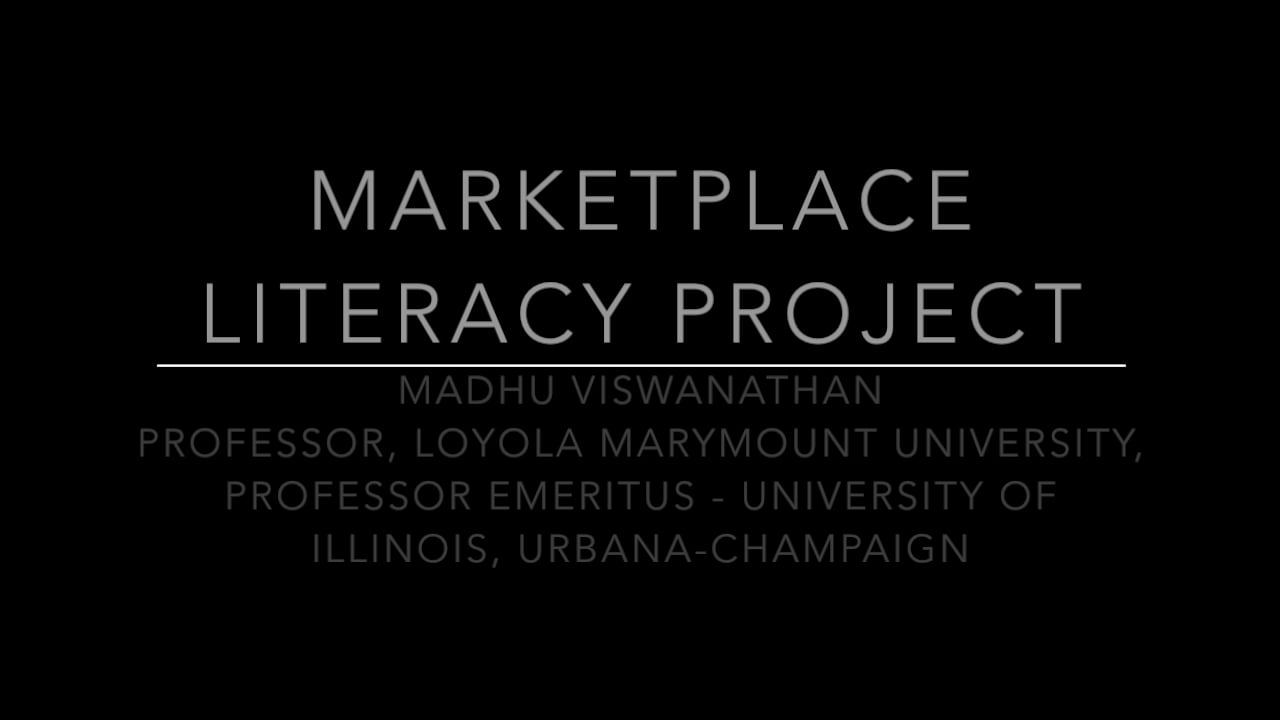By: Maya Abouelnasr and Mostafa Awwad
@EmEn1125
@MostafaAwwad565
Photo Credit: Madhubalan Viswanathan’s video published on Vimeo
In a world where there is unequal access to essential needs and services, a mid-February webinar spotlighted how marketplace literacy programs can provide the less fortunate with the tools to alleviate poverty and economic burden.
Launched in 2003 by Loyola Marymount Professor of Marketing, Madhubalan Viswanathan, the Marketplace Literacy project helps educate people from low income backgrounds on their rights as entrepreneurs and consumers. It also provides them with vocational skills and the self-confidence needed for effective participation in business dealings.
Since the first marketplace literacy program was launched in India in 2003, it has been offered in seven other countries – Argentina, Uganda, Kenya, Tanzania, Mexico, Honduras and the United States.
“It’s very critical to understand more [about marketplace literacy and poverty dynamics] – not just for learning – but also because you will put it to good use if you just want to sort of help get them out of the poverty trap,” Business Professor of Practice and Director of the Gerhart Center Ali Awni said in a Gerhart Center webinar.
He explained that the origin of the project came from what he observed as a lack of knowledge by low-income individuals on how marketplaces functioned.
Viswanathan and his team also noted that these individuals did not have a full grasp of consumer and entrepreneurial rights.
Both of these factors were barriers to evolving subsistence marketplaces, which are markets that cater to those who live in extreme poverty and are challenged by unstable, unpredictable living conditions, into sustainable ones.
In order to better understand these marketplaces’ dynamics, the project’s bottom-up approach emphasizes the need to study the micro-level details of these living conditions.
“Such micro-level details are often the most challenging to learn and the most neglected in terms of informing practice,“ Viswanathan added.
He added that this is the case because businesses tend to take a top-down approach in which their marketing strategies are most accessible to the middle and upper classes, thus excluding illiterate or subsistence audiences.
To overcome this barrier of non-accessible language, marketplace literacy programs employ pictures to teach basic business and marketing lessons.
One of these lessons involves presenting these low-income individuals with pictures of money, a wholesale store, delivery truck, farmer, retail store and a consumer.
Students would be given these pictures to place on a chart with concentric circles and they would have to place the most important factor needed to run a business in the center.
Viswanathan explained these low-income groups would often regard money as being the most important factor, to which he and his team would explain that it is the consumers.
Professor and Director of the Social Research Center (SRC) Hoda Rashad said that the biggest barrier to poverty alleviation in Egypt is the sheer size and vulnerabilities of those in poverty.
According to the Central Agency for Public Mobilization and Statistics’ (CAPMAS) 2019/2020 fiscal year report, Egypt’s poverty rate is 29.7 percent, while the extreme poverty rate is 4.5 percent.
This means that around 30-35 million Egyptians struggle to afford essentials such as food, healthcare, shelter and education.
Rashad explained that another key challenge that heightens these struggles is the narrow approach with which poverty is handled.
“The national development agenda with its many transformative components does not explicitly target equalizing the opportunities and ensuring higher benefits to those most in need,” Rashad told The Caravan.
A poverty alleviation program that has been in place in Egypt since December 2014 is the conditional and unconditional cash transfer project “Takaful and Karama” (“Solidarity and Dignity”), which serves 2.6 million households.
Takaful and Karama, directed by the current Minister of Social Solidarity Nivine El-Kabbag, consists of two programs.
Karama provides a monthly stipend to the elderly and the severely handicapped of EGP 320 per beneficiary.
Takaful is a conditional cash transfer that is provided four times a year to poor families with children, who are initially given EGP 320 with increments of anywhere from EGP 60 to EGP 140 per child, depending on the ages of the children.
This cash transfer is conditional because it is dependent on children over the age of six attending school as well as receiving regular health care.
Rashad explained that while marketplace literacy education in Egypt could be a viable option to consider implementing, it would require bringing together and building on dispersed actions and actors.
She elaborated that the reduction of poverty rates in Egypt could be better achieved through prioritizing children’s futures to break the poverty cycle.
Rashad also suggested providing community upgrading and skills development with decent work to those already in low-income groups.
She noted that several civil society organizations and state bodies, namely the National Council for Women and the Ministry of Manpower, have previously attempted to create programs with a similar objective as marketplace literacy.
“SRC/AUC have been engaged closely with the Ministry of Manpower to support women entrepreneurship and vocational training. However, these efforts, while helpful, have not been scaled up enough to reach an appreciable impact,” Rashad said.
The webinar was part of the Gerhart Center’s “The Aftermath of COVID-19: The New Social Impact Ecosystem” webinar series, wherein experts discuss non-mainstream concepts relating to philanthropy, civic engagement and business that could prove beneficial post-COVID.
